Festive atmosphere in Velvet city
By Ananth PALAKIDNAR
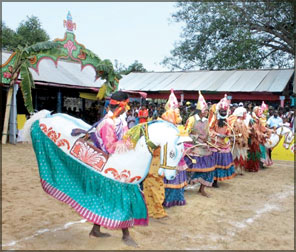 |
| A traditional
dance being performed by a group |
In the good old maritime days, Velvettiturai (VVT for short) was a
popular port not only among traders but also among ship builders.
Velvettiturai in the northern tip of the Jaffna peninsula derived its
name from `Velvet' as the region had remained a popular spot among
Velvet traders from the Middle East and South Asian countries.
According to historians, when the sail ships reigned the oceans
Velvettiturai functioned as a port where the sail ships were built and
repaired by ship-builders in the region and this was evident in the
records maintained by the premier shipping institution, Lloyds Register.
In the early 1930s a sail ship was built by the Velvettiturai ship
builders following a request by an American millionaire. The ship named,
`Annapoorani' sailed to America navigated by its builders along with the
American owner.
Therefore, the life and times of the people of Velvettiturai remained
part and parcel with the seas around them and a veteran swimmer called
Narayanaswami from Velvettiturai became a legend by being the first Sri
Lankan to cross the Palk Straits in the early 1960s.
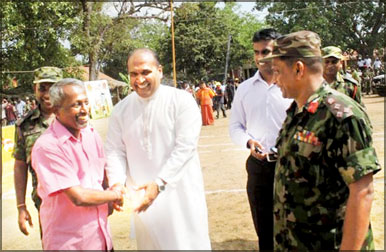
Jaffna security forces commander Major General Mahinda
Hathurusinghe (in national) being welcomed on arrival at the
venue by a resident Major General Hathurusinghe is the
brainchild behind the festivities |
|
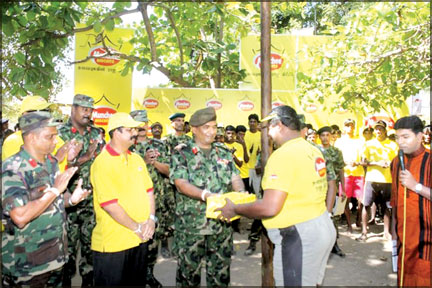
A winner receiving his prize |
The people of Velvettiturai were also well-known for their spiritual
activities and the festivities throughout the year. Temples in every
nook and corner in Velvettiturai are famous for their festivals and
well-known famous artistes from South India also arrived at this port
city to perform during the festive season and the people from various
parts of the peninsula gathered in Velvettiturai to participate in the
festivities.
However, the three-decades of turbulent period in the North had not
only devastated the livelihood of the people of Velvettiturai, the
turbulent conditions had even shattered the pleasant atmosphere
prevailed in early times.
With troubles in the North and East coming to an end in 2009, the
city of Jaffna became the focal point of every event that took place in
the peninsula. The Security Forces Command in Jaffna celebrated the
Sinhala-Tamil New Year this time with greater participation of the
people of Velvettiturai.
The region which had remained with deadly gunfire and explosions
along with internal displacements, turned into a carnival atmosphere
with the dawn of the Sinhala and Tamil New Year last week.
The Velvil Pillaiyar Temple in a hamlet called Velvetti adjoining
Velvettiturai where cultural events in connection with the New Year
festival were coordinated by the Security Forces command with the
participation of various government and private institutions in the
North.
Similar to other parts of the country, the beginning of the April
festive season is a prelude to the dawn of spring in the North where
several temples hold their festivals in April.
The two-day New Year festival in Velvettiturai also highlighted the
revival of livelihood of the people in the region. Fishing in
Velvettitural had been affected due to the conflict situation in the
North with fisherfolk suffering immensely as the seas of VVT remained
vulnerable to terrorist activities.
Restrictions on fishing hours had crippled fisherfolk in VVT and in
the North at large.
However, fishing restrictions were lifted following the end of the
disturbances and brought back the smiles on the faces of fishermen in
VVT with vast improvement in their earning capacity.
Hence choosing VVT as the centre-stage for the Sinhala-Hindu New Year
by the Security Forces Command in Jaffna was praiseworthy.
Following religious observances at the Velvil Pillaiyar temple, the
cultural and traditional sporting events were celebrated with greater
enthusiasm of youth in the area. Independent Television Network (ITN)
telecast the events live from Velvettiturai and the Director of the
ITN's Tamil service Vasantham, K. Kulendran told the Sunday Observer
that the New Year festival in the North was a dual celebration for ITN
since for the first time in nearly 30 years, the television tower began
operations with test transmissions last week.
The Kokavil television tower in Mankulam was destroyed by terrorists
in the early 1980 depriving the northerners of viewing prime national
television channels. A musical program with the participation of South
Indian singers Krishna Iyer, Priya Imesh and Anita was held at Point
Pedro, another coastal city in the northern tip of the Jaffna peninsula.
Hartley College grounds in Point Pedro, was the venue for the ITN
sponsored musical program of Indian singers. The April New Year season
in the North this year highlighted overall socio-economic developments
achieved by the people of Jaffna in a short spell of two years since the
troubles ended in 2009.
While the people in Jaffna celebrated the New Year in a peaceful
atmosphere with goods and services available in plenty, traders from the
South including those who brought fire crackers also enjoyed themselves
seeing the bulk of their goods lighting up the Jaffna skies.
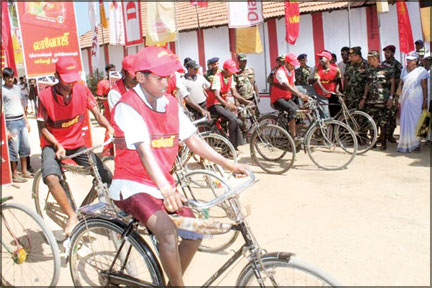
A bicycle race about to begin |
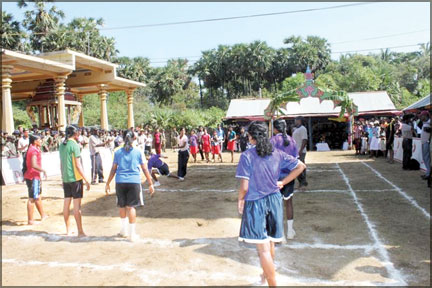
A Kabbadi game in progress |
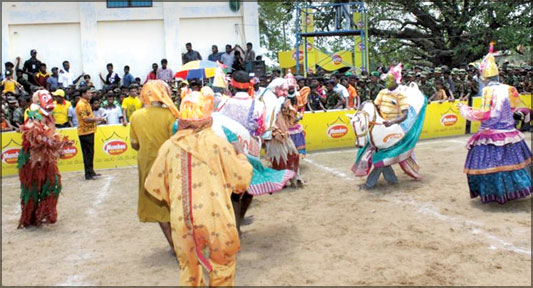
What a time they had entertaining the crowds! |
|
|

